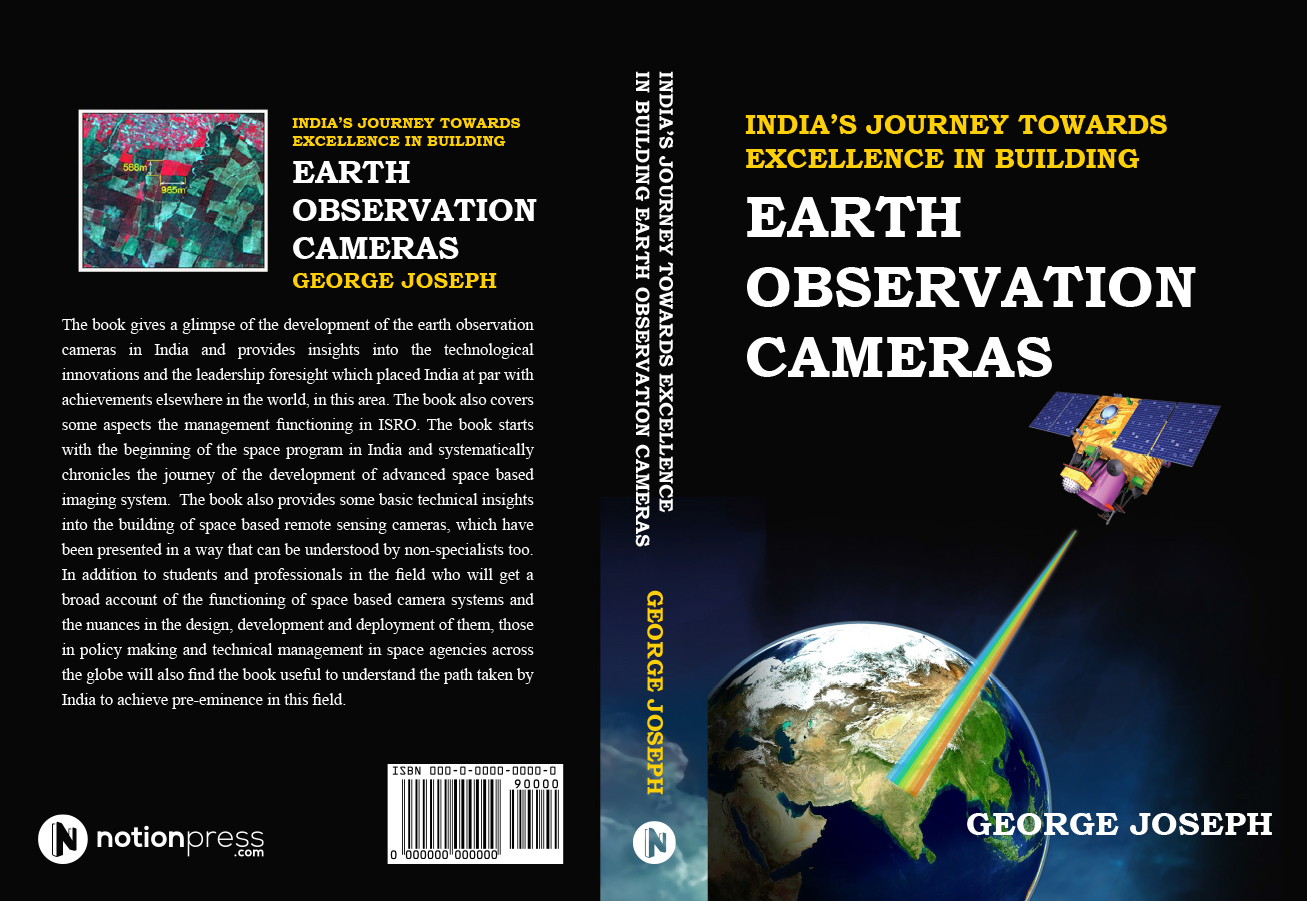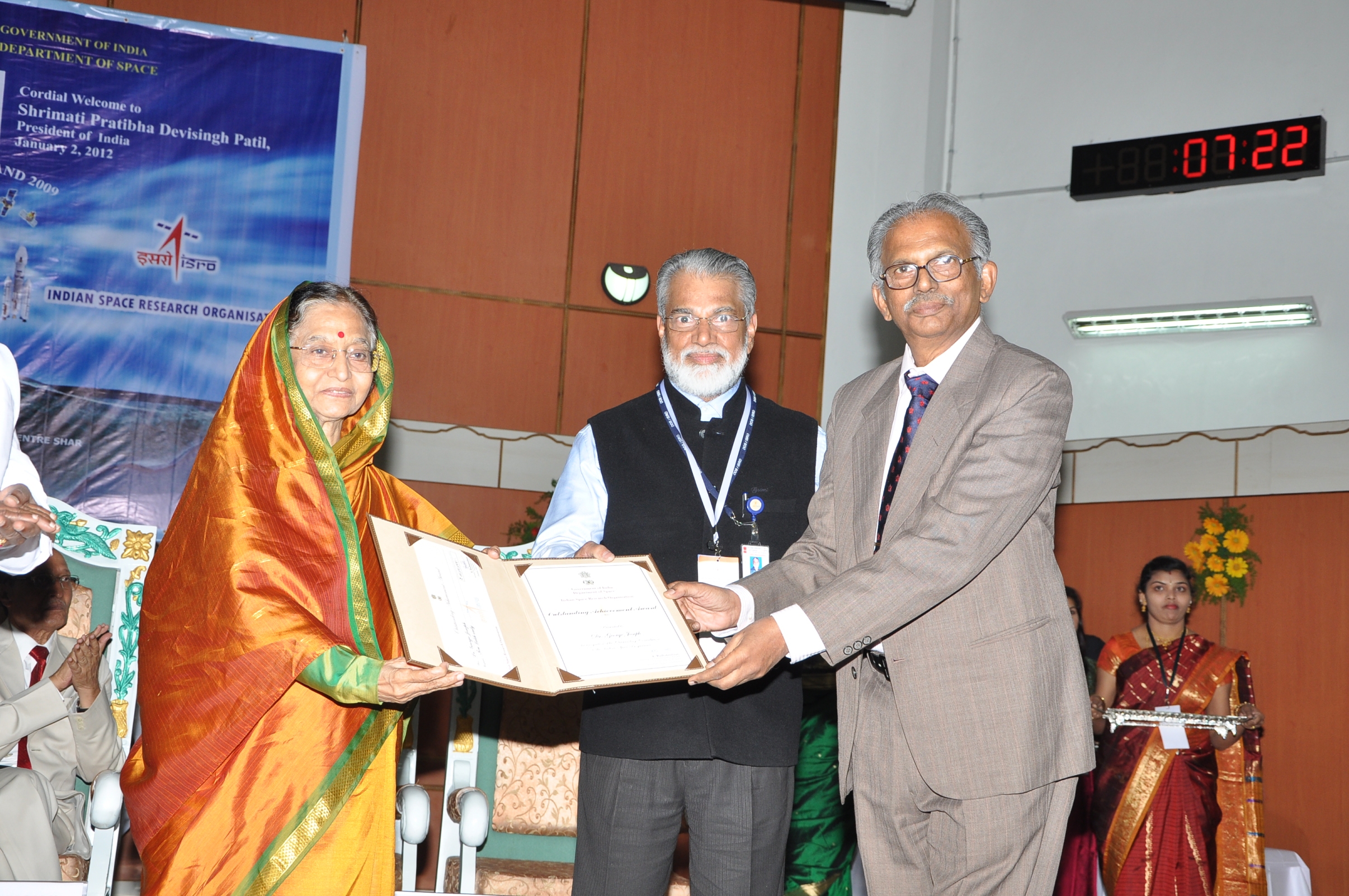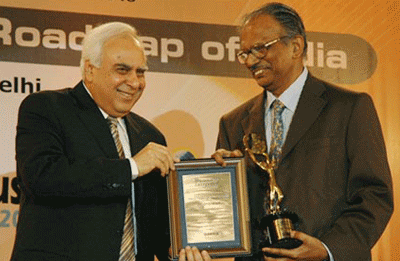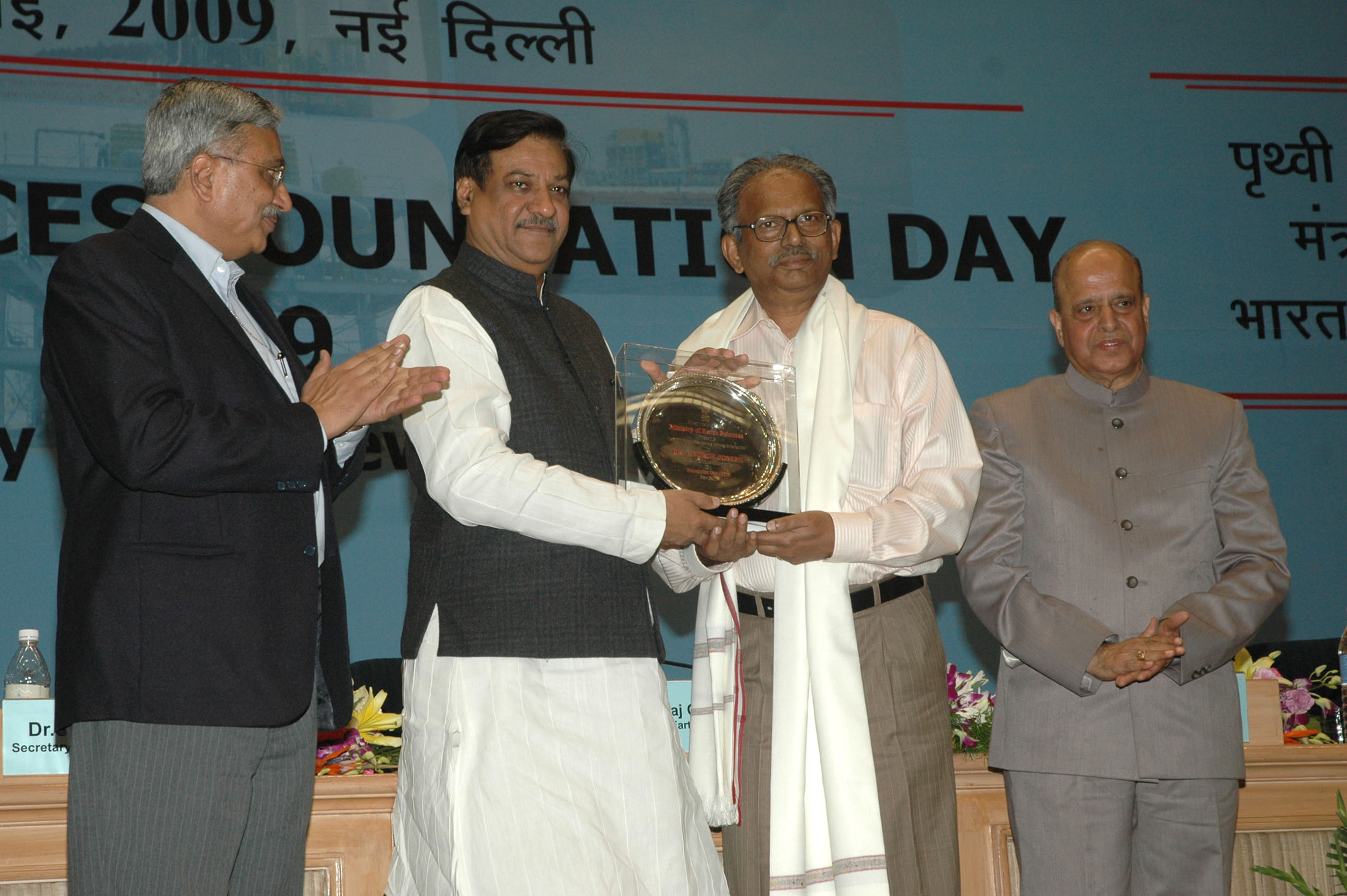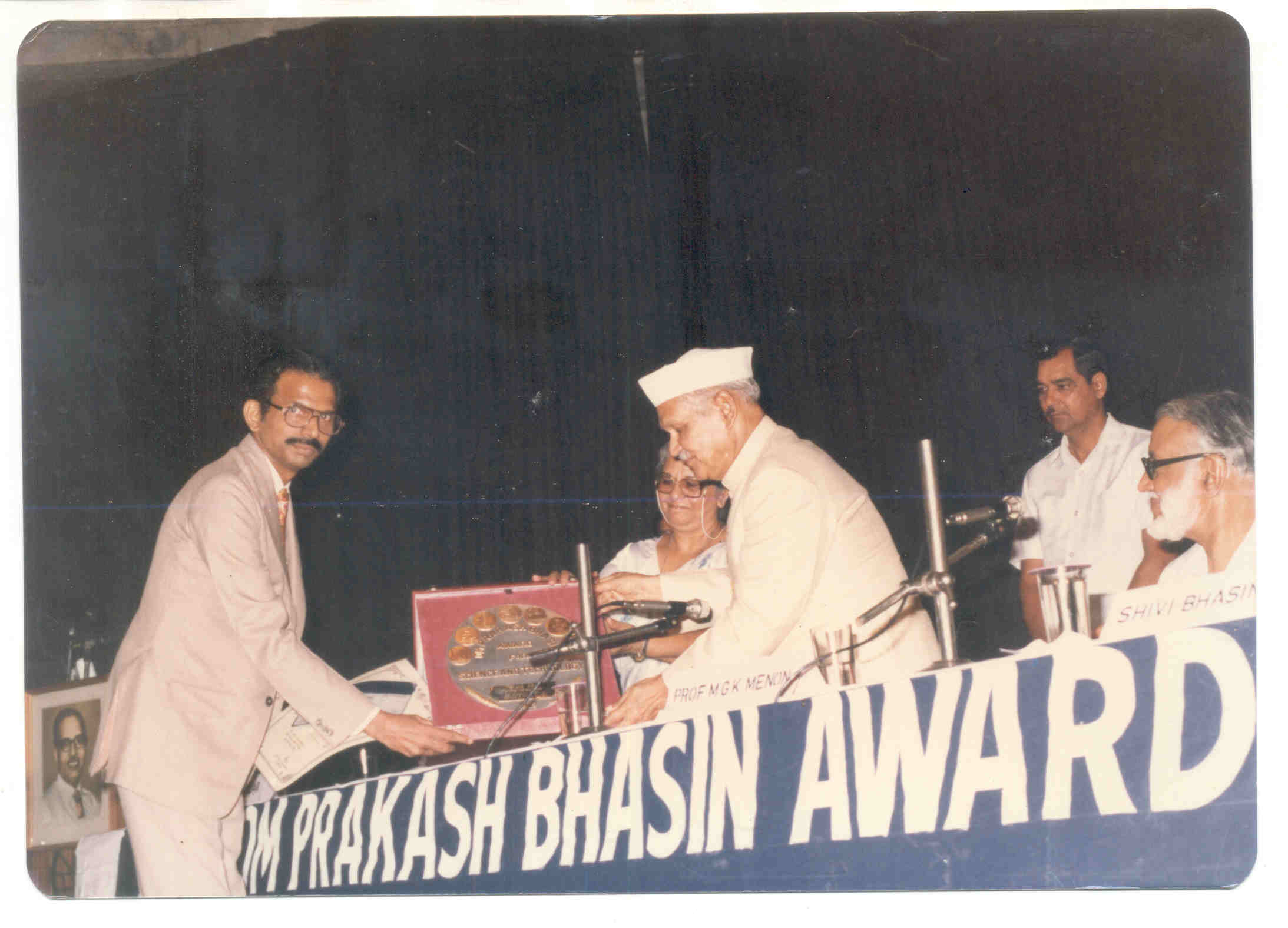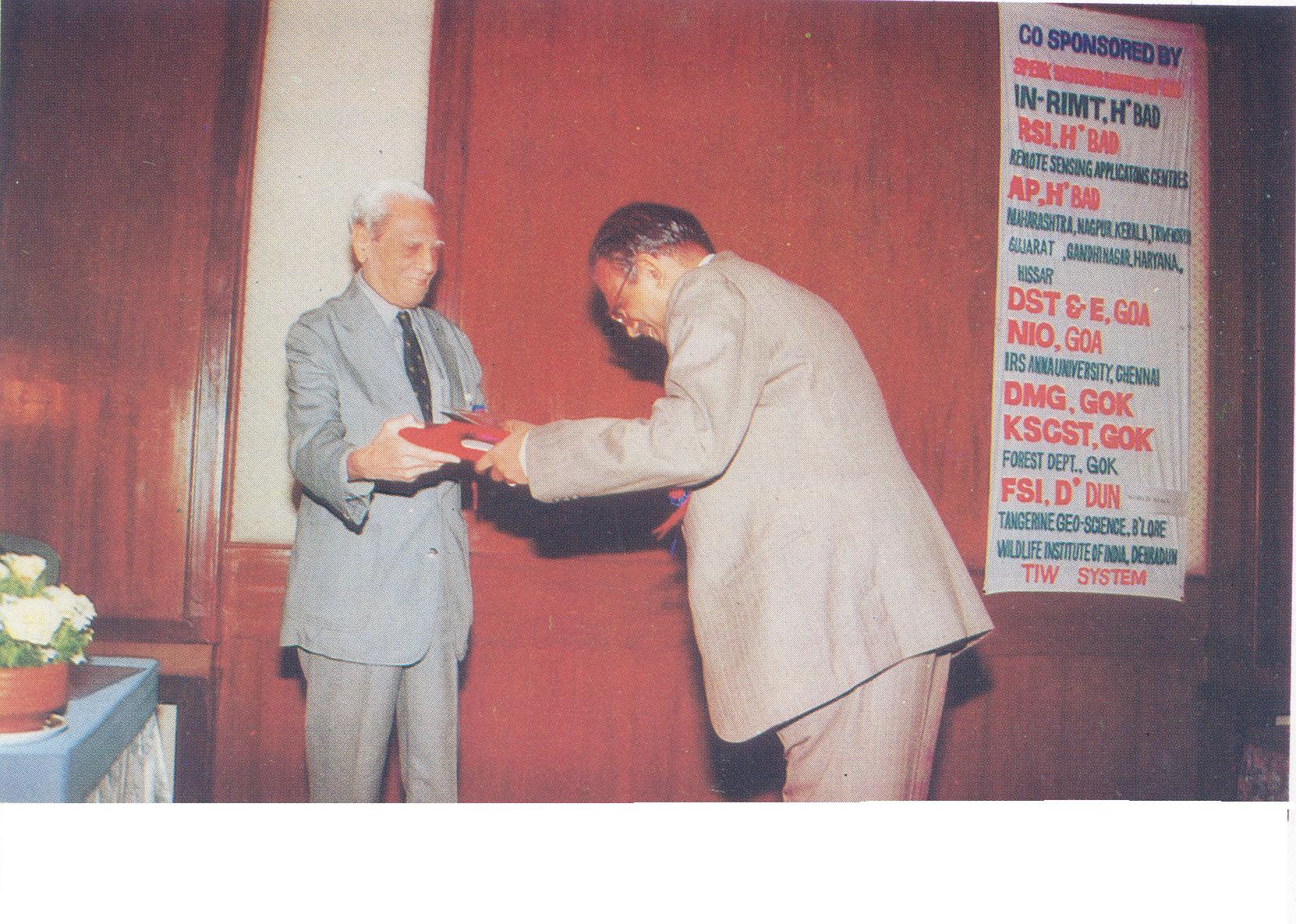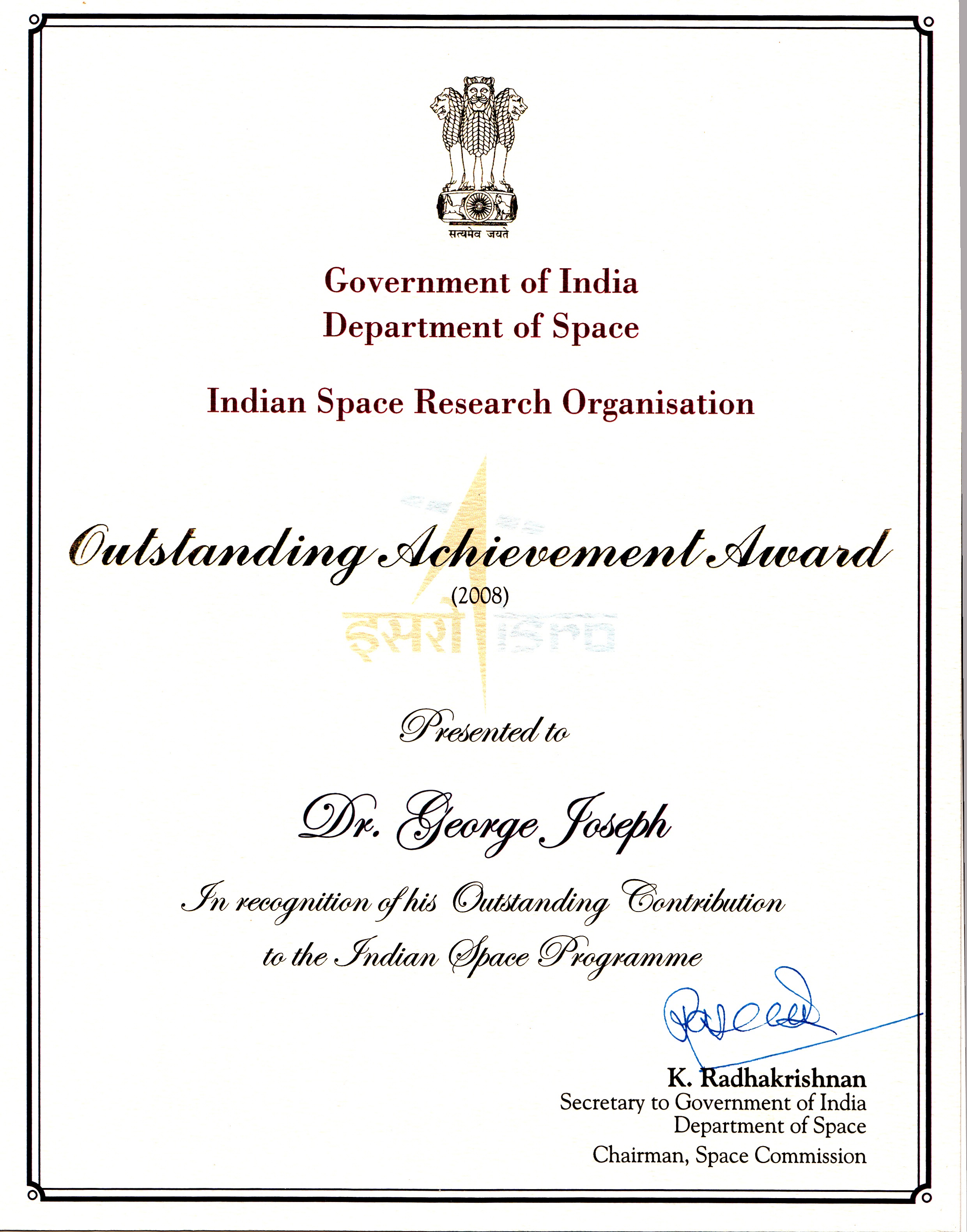“This book gives a glimpse of the author’s own account of this
spectacular journey from humble beginnings, the establishment of a
unique world class facility that turned out world class earth
observation systems to bring ISRO to this enviable position. I
am confident the book will appeal to all those who are interested in the
evolution of remote sensor technology in India as well as professionals
who want to get an insight into the technical complexities in realising
a space borne camera system.”
Dr K Kasturirangan, former Chairman ISRO/ Secretary DOS in the Preamble to the book.
“I compliment Dr. Joseph for having put together the historical
perspective of developing space based camera system in ISRO and the
technical innovations carried out during the realization of the camera
system, all in one book. I hope the book will interest a broad range of
readers both within and outside the country. Those who were part of the
journey will feel a sense of satisfaction and proud of what they could
achieve and the younger readers will be inspired and encouraged to be
part of this excitement. The book should interest all those who want to
know how India has achieved preeminence in space based remote sensing. I
wish the book wide readership.”
A.S. Kiran Kumar Chairman ISRO/Secretary DOS, in the foreword to the book
Below front matter is provided. For details refer to the above book.
INDIA’S JOURNEY TOWARDS EXCELLENCE IN BUILDING
EARTH OBSERVATION CAMERAS
Notion Press
Old No. 38, New No. 6
McNichols Road, Chetpet
Chennai – 600 031
Re-Published by Notion Press 2016
Copyright © George Joseph 2016
All Rights Reserved.
This book has been published in good faith that the work of the
author is original.All efforts have been taken to make the material
error-free. However, the author and the publisher disclaim the
responsibility. No part of this book may be used, reproduced in any
manner whatsoever without written permission from the author, except in
the case of brief quotations embodied in critical articles and reviews.
Foreword
The Indian Space program was initiated with a vision to use space
technology for national development in the thrust areas of
communication, navigation, resource survey/management and meteorological
applications. Towards meeting these objectives, two major operational
systems have been established – the Indian National Satellite (INSAT)
for telecommunication, television broadcasting, and meteorological
services and the Indian Remote Sensing Satellite (IRS) for monitoring
and management of natural resources and Disaster Management Support.
India is also establishing a constellation of Indian regional navigation
satellite system (IRNSS) to provide accurate position information
service. These systems have taken the benefits of space technology to
the society at the grassroots level. In addition to the application
driven programs, front ranking scientific investigations are being
carried out in the fields of astronomy, atmospheric sciences and
planetary exploration. Over the years, the space program has become
largely self-reliant with capability to design and build satellites for
providing space services and to launch them using indigenously designed
and developed launch vehicles.
In India, development of satellite platforms for acquisition of
remotely sensed data began in late seventies with the Bhaskara mission
which had a two-band TV payload for land applications and a Satellite
Microwave Radiometer (SAMIR) for oceanographic/atmospheric applications.
Since then, considerable progress has been achieved in building complex
space platforms with advanced sensors to provide wide range of
information available in the electromagnetic spectrum extending from
visible to microwave region. India has now one of the largest
constellations of civilian earth observation satellites providing
information on various sectors such as agriculture, land and water
resources, forestry, fisheries, environment, natural disasters, urban
planning and infrastructure development, rural development and so on. In
this journey ISRO has developed expertise in various technologies.
In the present book Dr. George Joseph discusses one aspect of the
space based remote sensing technology namely the imaging system. The
book traces the evolution of earth observation cameras in ISRO; how from
a humble beginning of a two band framing camera ISRO went on to
developing world class imaging system from space and the innovations
carried out in the course of development of these sensors. The book also
discusses the rational to choose various camera specifications based on
the application needs. Dr. Joseph is eminently qualified to write on
this subject since the development of electro-optical sensors in ISRO
started under his overall guidance. Thanks to great foresight of Dr.
George Joseph, ISRO became one of the early adopters of CCD based
pushbroom technology, when established earth observation systems were
still using opto-mechanical scanners. Use of pushbroom technology paved
the way for achieving leadership in providing high resolution imaging in
civilian domain in the areas of ocean colour imaging sensor,
panchromatic camera for IRS 1C, and CCD payload from geosynchronous
platform. I compliment Dr. Joseph for having put together the historical
perspective of developing space based camera system in ISRO and the
technical innovations carried out during the realization of the camera
system, all in one book. I hope the book will interest a broad range of
readers both within and outside the country. Those who were part of the
journey will feel a sense of satisfaction and proud of what they could
achieve and the younger readers will be inspired and encouraged to be
part of this excitement. The book should interest all those who want to
know how India has achieved preeminence in space based remote sensing. I
wish the book wide readership.
A.S. Kiran Kumar
Chairman ISRO/Secretary DOS
Preface
History changed on October 4, 1957, when the Soviet Union
successfully launched the world’s first artificial satellite Sputnik
that marked the start of the space age. Barely five years after this
historic event, convinced by the potential of this advanced technology
to address the real problems of man and society, India initiated the
space program. During the past five decades India has made rapid strides
and achieved a pre-eminence position among the space faring nations in
developing technology and applying it for the national development in
various sectors. One of the areas in which India has excelled is Remote
Sensing both in technology and its application. India has a
constellation of earth observing (EO) satellites serving both national
and inter-national community. The heart of the remote sensing satellite
is the imaging sensor. Development of electro-optical sensors in the
Indian Space Research Organisation (ISRO) was initiated at the Space
Applications Centre (SAC). I had the privilege of leading the team from
the very beginning. This book traces the development of the EO cameras
and provides insight into the technological innovations and the
leadership foresight which placed India at par with the achievement
elsewhere in this area.
To have continuity Chapter 1 starts with evolution of the Indian
Space Program and traces the initiation and growth of remote sensing
activity in India. Chapter 2 narrates initial steps taken in setting up a
team for sensor development. In order to appreciate the technical
details given in the following chapters Chapter 3 presents an overview
of earth observation camera system and importance of some of the
terminologies used. Chapter 4 brings forth the evolution of aerial
sensor development. Chapter 5 describes the technical issues in
designing an imaging system from a spinning satellite and realization of
the TV cameras for the first remote sensing satellite of India-
Bhaskara, which laid the foundation for space based sensor activities.
Chapters 6-8 bring to light the technical issues in the development of
observation system for the Indian RemoteSensing Satellites and
innovations adopted at various stages of realization of the sensor
systems. These chapters also bring out how the Indian remote sensing
activity evolved as a self-reliant, application driven program with
vital links to the user community. Chapter 9 talks about the evolution
of planetary exploration and future possibilities. Chapter 10
illustrates how the data from the IRS satellite is used by the
international community. Chapter 11 gives a broad summary and some
general observations of the work culture of ISRO and challenges in the
development of future earth observation systems. The Bhaskara TV camera
failure analysis, which led to the subsequent successful operation, is
brought out in Appendix-1. In order not to lose the continuity some of
the technical details are given in Appendix-2, under supplementary notes
(SN). Readers who want to get a quick glimpse of the subject may skip
these notes; however, going through the notes may help the reader to
appreciate the technical nuances in realizing the cameras. Appendix-3
gives a list of India’s space based electro-optical earth observation
cameras with its main characteristics. In order to facilitate non
specialists, Appendix-4 contains glossary of terms of relevance to this
book. I have included a few anecdotes/incidents some of which I heard
from Prof. Pisharoty during our long wait at the airports to catch
flights.
I must make it abundantly clear that the statements as well as
observations I have made here of persons/ incidences/organizations are
solely my personal views and they do not reflect the official policies
or positions of ISRO nor have the endorsement of ISRO as an organization
As in any major projects, the success in realizing the earth
observation systems discussed here was a team effort; various Centres of
ISRO, mainly by the sensor development team at SAC contributed to this
endeavor. There are so many of these wonderful colleagues who have
contributed to the development of these world class sensors. It is
practically impossible to mention each of them by name; however I have
named some of the leaders who contributed to this effort during the
formative stage of the program. If I have left out some names it is not
intentional but inadvertent.
I am grateful to Prof. Yash Pal, the first director of SAC, for
inviting me to join SAC and Prof. P. R. Pisharoty for persuading me to
contribute to development of remote sensing leaving my basic research at
the TataInstitute of Fundamental Research (TIFR), Mumbai. I am indebted
to Prof. U. R. Rao, former Chairman ISRO, for his inspirational support
during my stay in ISRO.
I am grateful to Mr. A. S. Kiran Kumar, Chairman ISRO, for writing
the foreword. Mr. Kiran Kumar played a decisive role in all the
technological innovations discussed in this book. I am indebted to Dr.
Kasturirangan, former Chairman ISRO, for critically reviewing the
manuscript, providing very useful suggestions and writing the preamble. I
would also like to express my sincere thanks to Dr. Rangan for his
enthusiastic support and encouragement during the course of my career in
ISRO. I am thankful to Directors of the Space Applications Centre who
extended to me the necessary facilities in the course of preparation for
the book. I am thankful to Mr. Padmanabha K Joshi, Coordinator, Vikram
Sarabhai Archives, Nehru Foundation for Development, who painstakingly
collected and made available to me some of the original documents
relating to the early phase of the space program. I am thankful to a
number of my colleagues, in particular Dr. R. R. Navalgund, former
Director, SAC, Mr. D. R. M. Samudraiaha, former Deputy Director SAC, and
Dr. J. V. Thomas, Program Manager, ISRO HQ, and Mr. Adalka Dheeraj, SAC
who have critically gone through the manuscript and made very useful
suggestions. I sincerely acknowledge their contributions. I am thankful
to Mr. Devan A Raval for providing secretarial assistance during the
preparation of the manuscript.
I am grateful to my wife Mercy for her encouragement and moral support without which the book would not have been completed.
George Joseph
Preamble
K. Kasturirangan*
(*Former Chairman ISRO/Secretary DOS.)
Soon after independence, the Indian political leadership recognized
that the country needs, a variety of inputs encompassing social,
economic, educational, industrial, agricultural, infrastructural among
others, to take India on the path of speedy progress and development. In
this context, the crucial role of science and technology was realized
to be an important element as a part of early planning. Of the many
initiatives to bring the benefits of science and technology to the
country, the space program, which is the foresight of a great visionary
and physicist Vikram Sarabhai, stands as a shining example of taking
technology to solve the real problems facing the nation. From a humble
beginning of launching a sounding rocket in 1963 from Thumba (a village
in south India) for atmospheric studies, the Indian Space Research
Organization (ISRO) has today established operational space systems and
services, attained selfreliance in development of indigenous technology
and accomplished exemplary feats in space exploration, yet ensured that
benefit of space reaches the common man. The major uses of satellites
can be broadly classified into three categories: (1) to look at the
heavenly bodies – stars and galaxies – to understand their
characteristics, which will probably give us a better understanding of
the evolution of the universe and our own solar system-the space
science; (2) act as a relay ‘tower’ in the sky to receive and retransmit
the electromagnetic radiation-space communication, navigation etc; (3)
acting as an ‘eye in the sky’ to look at the Earth to get a synoptic
view of the Earth’s features, to derive information about the Earth and
its environment, weather system and various resources – both natural and
manmade – for its optimum management – known as Remote Sensing.
The Indian Space programme evolved through three major phases. The
first phase related to initiation of activities with the objective of
proof-of-concept evaluation, followed by the experimental phase
ofrealizing end-to-end capability demonstration and leading finally to
the operational phase for providing regular services. Since the present
book deals with remote sensing I shall elucidate these points with
respect to space based earth observation system. In the initiation
phase, one of the primary tasks was evaluation of the efficacy of space
systems as either alternative to conventional terrestrial systems or to
look at them as complementary or supplementary to the conventional
approaches, particularly in the area of resource management. Landsat,
launched by USA in 1972 provided a unique opportunity to scientists for
testing out the utility of a satellite based earth observation system
for obtaining timely, accurate and precise information of earth
resources. India after establishing its own Landsat receiving station
started receiving regularly remote sensing imagery over the country. The
initial years were more of a research exercise at using spacebased
imagery to establish its feasibility for natural resources inventory.
The exercise of establishing ground systems, integrating space based
data with conventional aerial and ground based data and working closely
with user community, provided several crucial insights for planning the
future operational remote sensing systems. During this period several
ground and aerial instruments were developed which facilitated to
understand the nuances of sensor development and data product
generation. The experimental phase was identified with a strategy to
realize systems where the potential of its use at the national level had
already been clearly demonstrated in the proof of concept phase. The
next step was to create an end-to-end capability in the design,
development and in-orbit management of space systems together with the
associated ground systems needed for the users. These were systems with
limited capability, realized within stringent cost and time controls. In
the case of remote sensing, the experimental satellites Bhaskara-1 and
Bhaskara-2 were the pioneering steps in this direction. The Bhaskara
mission, even with 1 km resolution, enabled developing the capability to
image from space, transmitting and processing the image information on
the ground, disseminating the data products to the users and getting
their response. This phase additionally facilitated competence building
at the core level, helped in the detailed evaluation of issues for
scaling the effort to the national level and set the rules relating to
the overall practices in system engineering. The overall demonstration
of the systemic approach in this phase paved the way forthe country to
create national systems at a much larger scale with bigger and more
sustained investments.
Building technological competence is a key factor to provide
sustained operational services to the country. Starting from basic
developments, ISRO has achieved a level of technology, which is world
class. The Indian Remote Sensing program is an excellent example of
realizing this level of world leadership. With the inputs from the
initiation and experimental phases as elaborated earlier, we were in a
position to take the next step, to achieve a quantum jump in terms of
establishing a space based Earth Observation system-the Indian Remote
Sensing Satellite (IRS) – for natural resources management and
environmental protection. The heart of such a system is the imaging
camera. The migration from a two band 1km resolution camera to 36 meter
four band camera was a big leap in technology. Innovative approach is
crucial to achieve such a development which is the theme of this book.
In contrast to expensive, heavy spacecraft with complex moving
mechanisms adopted by the world for earth observations, the first
generation IRS was designed with many innovations. A pioneering, step of
using solid-state detector (CCD) arrays ensured simplified designs,
besides triggering development of novel optical systems and an original
approach to low weight spacecraft. This gave better-cost efficiency,
improved turnaround time for manufacture, a high degree of reliability,
yet a performance comparable to best systems in the world. This choice
of solidstate detectors also offered better growth potential. The use of
CCD devices for imaging which did not have any flight pedigree at that
time might have seen as a risky step but it clearly demonstrated the
technological foresight. In fact later CCD based imaging system became a
world trend in imaging from space. With the launch of IRS1C in 1995,
ISRO could provide the highest spatial resolution imaging system to the
global remote sensing user community. The launch of follow-on satellites
– Resourcesat – provide a unique combination of multi resolution and
multi swath capability making them the most versatile earth observation
platform for earth resources monitoring. The Oceansat series provide
data specific to extracting parameters of the ocean. The launch of the
RISAT carrying C band SAR with multimode operation capability has added
to the fleet of Indian Earth observation system. In addition to these
low earth orbiting satellites India also have imaging system from
Geostationary orbit. In view of the excellent quality of data these
imaging systems provide, they have become part of global source for
remote sensing data.
The development of the electro-optical sensors in ISRO was initiated
and nurtured under the overall guidance of Dr. George Joseph. The name
of Dr. George Joseph is synonymous with the development of
electrooptical systems for space missions in this country. I came in
contact with Dr. George Joseph during my student days when we both used
to meet at the Hyderabad balloon facility for flying our respective
instruments, mine for looking at diffuse cosmic X-rays from space and
Dr. George Joseph for studying high energy cosmic rays. Our association
became closer when I was made the scientific coordinator for the three
scientific experiments flown on India’s first satellite – Aryabhata. Dr.
George Joseph and his colleagues from Tata Institute of Fundamental
Research designed and developed a payload for detecting neutrons and
gamma rays from the sun- a unique instrument with complex detection
systems using inorganic and organic scintillators. George brought to
bear with his extraordinary insight into developing complex instruments
for radiation detection and analysis. Soon after Aryabhata, Dr. George
Joseph was selected by the then Director of Space Application Centre
Prof. Yash Pal to initiate work on electro-optical systems for remote
sensing with its immediate application for ground based and air borne
studies with a futuristic vision of space borne observations. The
pioneering effort of Dr. George Joseph together with his colleagues, in
the area of electro-optical systems lead to the definition of the first
camera system for space in Bhaskara – India’s first earth observational
satellite. The choice of a suitable camera for this spinning satellite
was no easy task. I had the privilege of seeing Dr. George Joseph going
through various options meticulously and ultimately making the necessary
choice that led to the slow scan vidicon system onboard Bhaskara I and
its successor Bhaskara II. When there was an initial hiccup of corona
discharge in this pay load, on Bhaskara I, which was using high voltage
systems the analysis, interpretation and possible recovery from the
anomaly was all spear headed by George Joseph along with his very
illustrious colleague Mr. Kiran Kumar, who is now the Chairman of ISRO. I
watched with great admiration their efforts to understand the problem
from the perspective of physics, material behavior and its
incompatibilities in an environment of vacuum and temperature
variations, strategy for simulation and modeling all of which led to the
ultimate recovery of one of the cameras after 6 months, an
extraordinary feat! Dr. George Joseph’s next task was to develop a
sophisticated camera system for the IRS. Here again the task was to
catch up with the performance of the best of the contemporary systems
which was the preserve of only two western countries. He came out with
interesting innovation in the choice of the detector i.e. CCD, optics,
signal and image processing, feature analysis and identification besides
interesting calibration techniques. In the very first of the IRS
series, Dr. George Joseph and his team achieved a performance level of
the payload to the contemporary standard achieved by the two countries
at that time. Since then, he went on to design and develop camera
systems with more advanced characteristics for IRS 1C and 1 D, ocean
color monitors for OCEANSAT, camera for a high resolution satellite
called TES(Technology Experimental Satellite), satellite for
cartographic applications introducing stereoscopic capabilities etc..
It is one of the most remarkable feats in the annals of remote
sensing that in just two decades Dr. George Joseph put India on the
world map where it came to occupy a pre-eminent position. The
conceptualization, installation and operationalization of a variety of
complex infrastructure for the cameras needed for their design and
evaluation, development and testing including calibration and the unique
test setup for the optics with demands on extraordinary precision and
accuracy ultimately left a legacy which India can rightfully boast off
today.
The book also brings out the management aspects and the role played
by leadership which make ISRO stand out as a successful high-tech
organisation. This book gives a glimpse of the author’s own account of
this spectacular journey from humble beginnings, the establishment of a
unique world class facility that turned out world class earth
observation systems to bring ISRO to this enviable position. I am
confident the book will appeal to all those who are interested in the
evolution of remote sensor technology in India as well as professionals
who want to get an insight into, the technical complexities in realizing
a space borne camera system.
